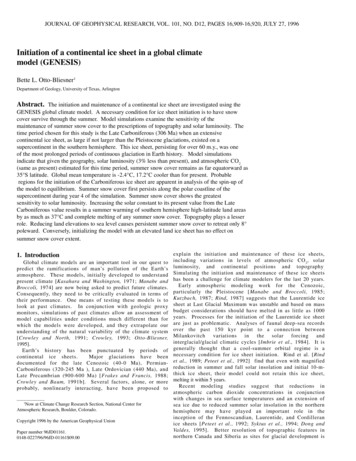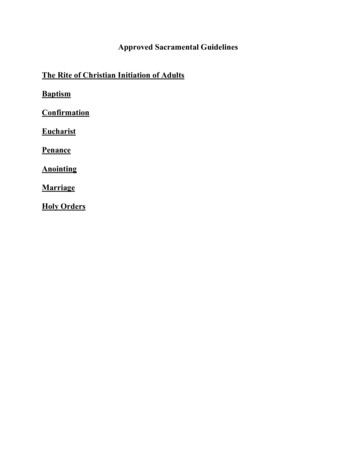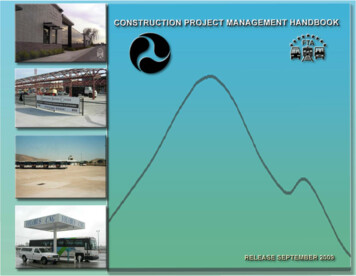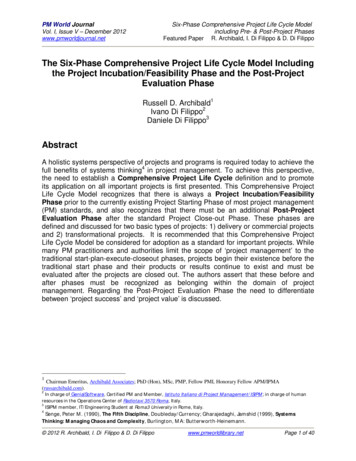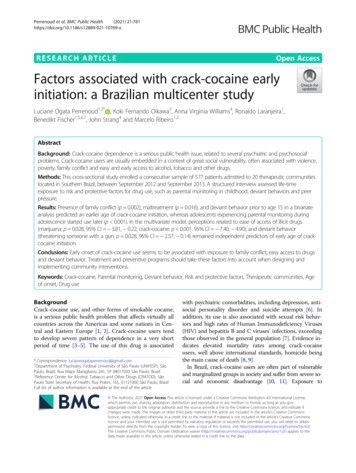
Transcription
2PROJECT INITIATIONPurposeThe purpose of Project Initiation is to begin to define the overall parameters of a project and establish the appropriate project management and quality environment required to completethe project.Development of the Project Charter is a pivotal starting pointfor the project, establishing the project definition that willserve as the foundation for all future efforts. The completion ofthis process is marked by the Project Kick-off Meeting, in whichthe Project Manager presents the Project Charter.Successful projects begin with a detailed project definition thatis understood and accepted by Stakeholders. Putting everythingdown in writing helps ensure a commitment among ProjectTeam members and between the team and the Stakeholders. Aspart of Project Initiation, an initial Project Plan is developed,which comprises the Project Charter, Cost/Scope/Schedule/Quality (CSSQ) documents, and preliminary risk identificationlist. These documents, once approved, ensure a consistentunderstanding of the project, help to set expectations, andidentify resources necessary to move the project to the nextlevel of detailed planning. Potential problems are identified sothat they can be addressed early in the project.Also during Project Initiation, a high-level Project Schedule isdeveloped as the roadmap to more detailed Project Planningand Project Execution and Control. This high-level schedule willbe refined over time, and will serve as the primary source ofinformation regarding project status and progress. An accurate,realistic, and complete schedule, rigorously maintained, isessential to the success of a project.Sponsorship of the project must be confirmed or gained duringProject Initiation. Having a Project Sponsor, and securingapproval early in the project management lifecycle, helps toensure a commitment to the project.51
52Section I:2 Project InitiationNYS Project Management GuidebookList of ProcessesThis phase consists of the following processes: Prepare for the Project, where the Project Sponsor andinitial Project Team are identified and work with theProject Manager to create the Project Charter. Define Cost/Scope/Schedule/Quality (CSSQ), where theProject Manager, along with the Project Team define thescope of the project and identify the preliminary budget,high-level schedule and quality standards to complete theproject. Perform Risk Identification, where the Project Managerand Project Team begin to identify and document any risksassociated with the project. Develop Initial Project Plan, where the Project Managerand Project Team identify all Stakeholders and documenttheir involvement in the project, develop means of communicating with them, and compile all documentation createdduring Project Initiation to produce the Initial Project Plan. Confirm Approval to Proceed to Next Phase, where theProject Manager reviews and refines the Business Case,secures resources required for Project Planning and prepares the formal acceptance package for review andapproval by the Project Sponsor.The following chart illustrates all of the processes and deliverables of this phase in the context of the project managementlifecycle.
Section I:2 Project InitiationNYS Project Management GuidebookFigure 2-1Project PlanningProject InitiationProject OriginationPrepare for the ProjectConduct Planning Kick-offIdentify Project SponsorDevelop Project ProposalOrient New Team MembersIdentify Project TeamDevelop Business CaseProjectProposalDevelop Proposed SolutionReview Historical InformationDevelop Project CharterReview Project MaterialsProjectCharterKick Off Project PlanningConduct Kick-off MeetingEstablish Project RepositoryRefine CSSQRefine Project ScopeRefine Project ScheduleDefine CSSQRefine Quality StandardsDefine Project ScopeRefine Project BudgetDevelop High-Level ScheduleEvaluationCriteriaIdentify Quality StandardsEstablish Project BudgetEvaluate Project ProposalsPresent Project ProposalPerform Risk AssessmentIdentify RisksQuantify RisksDevelop Risk Mgmt PlanPerform Risk IdentificationScreen Project ProposalsRate Project ProposalsScope StatementHigh-Level ScheduleQuality ManagementPlanPreliminary BudgetEstimateEvaluationRatingsIdentify RisksDocument RisksRefine Project PlanDefine Change Control ProcessList of RisksDefine Acceptance MgmtDefine Issue Mgmt & EscalationRefine Communications PlanDevelop Initial Project PlanDefine OrganizationalChange Management PlanDocument StakeholderInvolvementEstablish Time/Cost BaselineDevelop Communications PlanSelectionCriteriaDevelop Project TeamProduce Initial Project PlanDescription ofStakeholderInvolvementCommunication PlanDevelop Implementation/Transition PlanSelect ProjectsConfirm Approval to ProceedPrioritize Project ProposalsNotify Project SponsorConfirm Approval to ProceedReview/Refine Business CaseChoose ProjectsProposalDecisionNoticeReview/Refine Business CasePrepare for AcceptanceGain Approval SignaturePrepare for AcceptanceApproval FormGain Approval Signature53
54Section I:2 Project InitiationNYS Project Management GuidebookList of RolesThe following roles are involved in carrying out the processesof this phase. Descriptions of these roles can be found in theSection I Introduction. Project ManagerProject SponsorProject Team MembersCustomerCustomer RepresentativesStakeholdersPerforming OrganizationList of DeliverablesProject deliverables for this phase fall into three categories ofimportance and formality: Phase deliverables – major deliverables approved by theProject Sponsor or a designated alternate that allows theproject to proceed to the next phase. Process deliverables – drafts of major deliverables orminor deliverables that may or may not require a formalsign-off but nevertheless must be reviewed by Project Teammembers, Customer Decision-Makers, and the ProjectSponsor. The review validates the project’s progress, andallows the Project Manager to move on to the next processin confidence. Task deliverables – drafts of process deliverables orworks-in-progress that are verified within the Project Team,and may or may not be reviewed by the Project Sponsor orCustomer Representatives. Each task culminates with theproduction of one or more tangible deliverables, whichallows the Project Manager to monitor project progressusing concrete and real results.Figure 2-2 lists all Project Initiation tasks and their outcomesand deliverables.
Section I:2 Project Initiation55NYS Project Management GuidebookFigure 2-2ProcessesPrepare forthe ProjectTasksIdentify Project SponsorIdentify Initial Project TeamReview Historical InformationDevelop Project CharterConduct Project Kick-off MeetingEstablish Project RepositoryDefine CSSQDefine Project ScopeDevelop High-Level ScheduleIdentify Quality StandardsEstablish Project BudgetPerformRisk IdentificationIdentify RisksDocument RisksDevelop InitialProject PlanIdentify and DocumentStakeholders’ InvolvementTask Deliverables(Outcomes)Project SponsorProject TeamInformation ReviewedProject CharterKick-off MeetingProject RepositoryScope StatementHigh-level Project ScheduleQuality Management PlanPreliminary Budget EstimateRisks and ImpactsList of RisksDescription of StakeholderInvolvementDevelop Communications PlanCommunications PlanCompile All Information toProduce the Initial Project PlanInitial Project PlanConfirm Approval toReview/Refine Business CaseProceed to Next Phase Prepare Formal AcceptancePackageGain Approval Signaturefrom Project SponsorRefined Business CaseApproval FormSigned Approval FormFigure 2-3 illustrates the evolution of deliverables from taskthrough process to phase output.
56Section I:2 Project InitiationNYS Project Management GuidebookFigure 2-3Evolution ofProjectInitiationDeliverablesPrepare for the ProjectIdentify Project SponsorIdentify Project TeamReview Historical InformationProjectCharterDevelop Project CharterConduct Kick-off MeetingEstablish Project RepositoryCSSQ:Define CSSQDefine Project ScopeDevelop High-Level ScheduleIdentify Quality StandardsEstablish Project BudgetScope StatementHigh-Level ScheduleQuality Management PlanPreliminary BudgetEstimatePerform Risk IdentificationIdentify RisksDocument RisksList of RisksInitial Project PlanDevelop Initial Project PlanDocument StakeholderInvolvementDevelop Communications PlanProduce Initial Project PlanDescription of StakeholderInvolvementCommunications PlanConfirm Approval to ProceedReview/Refine Business CasePrepare for AcceptanceGain Approval SignatureApproval Form
Section I:2 Project Initiation57NYS Project Management Guidebook2.1PREPARE FOR THE PROJECTPurposeRoles Project Manager Project SponsorAfter formal project approval, the project is assigned to aProject Team whose first responsibility is to Prepare for theProject. The Project Manager must work to ensurethat the Performing Organization’s expectationsand all available project information are effectivelyconveyed to the Project Team. This can be donecollaboratively with the Performing Organization’smanagement team. Project Team Members StakeholdersTasks2.1.1 Identify the Project SponsorIf a Project Sponsor has not been identified, the Project Managermust work with Performing Organization management to identify and formally appoint someone to that position. Because theProject Sponsor will champion the project within the organization, secure spending authority and resources, and provide support to the Project Manager, it is imperative that he/she beidentified as early in the project management lifecycle as possible. Building the relationship between the Project Managerand the Project Sponsor is critical to project success.2.1.2 Identify the Initial Project TeamThe extent to which the Project Team has been defined at thispoint may vary. At a minimum the manager for the project andcertain individuals who can provide support inThe tasks topreparing for the project should be identified.Prepare for the Project are:2.1.1Identify the Project Sponsor2.1.2Identify the Initial Project Team2.1.3Review Historical Information2.1.4Develop the Project Charter2.1.5Conduct Project Kick-OffMeeting2.1.6Establish the Project RepositoryDuring Project Origination, a Project Proposalwas created. During Project Initiation, theProposal is reviewed to determine the rolesrequired to staff the project. With the help ofappropriate Stakeholders, the Project Sponsorshould take the lead in identifying the names ofindividuals within the Performing Organizationwho could fill the roles and become Project Team
58Section I:2 Project InitiationNYS Project Management Guidebookmembers. Names of the individuals needed to complete ProjectInitiation tasks will be documented in the Project Charter. Inselecting the Project Team, definition of the skills required to perform current tasks as well as skills for future project tasks isneeded. Immediate project needs should be met first. AfterProject Team members have been identified, the Project Managershould provide them with a project orientation and review withindividual team members their current and future roles on theproject. This establishes a baseline understanding of team members’ project responsibilities, which will be useful for conductingperformance reviews later in the project.Some agencies hold a meeting at the beginning of Project Initiation, where all potentialStakeholders come together to review the Project Proposal, discuss required roles, andassign Project Team members. In other agencies, establishing a Project Team is a lessformal process. You should choose and use the method to identify your Initial Project Team thatwill work best for your project and within your organization.Take the opportunity, from the outset, to establish the concept of a Project Team that comprises not only the folks reporting directly to you, but also your Project Sponsor, CustomerRepresentatives, Customer Decision-Makers, and all other players participating in the ProjectSchedule.2.1.3 Review Historical InformationDevelopment of the Project Charter will require review of documentation compiled or presented during Project Origination.Materials and information reviewed may include: the strategic plan, a formal document produced by thePerforming Organization that outlines the business goalsand direction over a designated number of years the Project Proposal, including the initial Business Case,which describes the project objectives and how they support the Performing Organization’s strategic businessdirection project selection criteria, defining the parameters used indetermining whether or not to undertake a project andidentifying its business justification and measurements ofits success information from a previous project similar in size, scopeand objectives project knowledge and experience of the individuals on theProject Team
Section I:2 Project Initiation59NYS Project Management Guidebook2.1.4 Develop the Project CharterThe purpose of developing the Project Charter is to documentcritical success factors and define and secure commitment forthe resources required to complete Project Initiation. The charter also documents the project’s mission, history, and background, describes the business problem the project is intendedto resolve, and lists the benefits to be realized by thePerforming Organization as a result of implementing the product or service.Information compiled during Project Origination is used andapplied in the development of the Project Charter. To furtherunderstand how the project was selected and to write an effective, comprehensive charter, the Project Manager must workwith the Project Sponsor and any appropriate subject matterexperts and Stakeholders.If issues or conflicting project expectations are uncovered whiledeveloping the Project Charter, the Project Manager must communicate with Stakeholders to resolve the discrepancies, elevate the issues when appropriate, and obtain consensus.Decisions that impact project expectations significantly shouldbe thoroughly documented.The Project Charter contains the following sections: Background Objective Critical Success Factors Required Resources Constraints Authority(see Figure 2-4, the New York State Project Charter)Developing the Project Charter is a collaborative effort. Working with the Project Sponsor, the Project Manager should document the outcomes that must be achieved in order for the project to be considered a success. These critical success factorsshould correlate with the goals and objectives of the project.An effective way to define a critical success factor is to complete the following sentence,“The project will be a success if ———— .”
60Section I:2 Project InitiationNYS Project Management GuidebookVarious areas of the Performing Organization may be requiredto provide resources to the project in order to complete ProjectInitiation. The Project Sponsor and Project Manager mustdetermine specific resource requirements and effort estimates,and include them in the charter. The Project Sponsor mustcommunicate with the affected areas of the PerformingOrganization, proactively gaining agreement and securing thenecessary resources.Once the Project Charter has been developed, the ProjectManager should schedule a meeting to review its contents,secure necessary resources, and gain formal approval. Meetingattendees should always include the Project Sponsor and themembers of Performing Organization Management whoseresources are affected. Attendees may also include other members of the Performing Organization who are able to provideresources that will add value to the project. During the meeting,the Project Manager presents the Project Charter for review.Resources are formally secured by gaining the signatures of theappropriate Performing Organization managers. At the conclusion of the meeting, the Project Sponsor will formally approve orreject the charter. Should the Project Sponsor reject the charter, he/ she must provide the reasons for rejection to allow theProject Manager to make necessary adjustments.Based on the contents of the Project Charter, the ProjectManager should have a general understanding of the amount ofeffort that will be required to complete Project Initiation andproduce an initial Project Plan. It is imperative that the ProjectManager begins to track the remaining Project Initiation effortsand communicate status. Items to discuss during status meetings include accomplishments, progress against schedules,work to be done, and any open issues that need resolution. Aspart of the Communications Plan for the project, a ProjectStatus Report should be prepared and reviewed during the meetings. See 2.4.2, Develop a Communications Plan and Figure2-10, the Project Status Report template, for more information.At this early stage in the project management lifecycle, the Project Manager needs toensure that only Project Initiation resources are secured. Resources required in subsequent project management lifecycle phases will be determined and documented later, in theProject Plan.
Section I:2 Project Initiation61NYS Project Management GuidebookFigure 2-4 New York State Project CharterNew York StateProject CharterPROJECT IDENTIFICATIONProject Name: Date:Project Manager: Project Sponsor:EnterEnterEnterEnterthethethetheProject Name.current Date.name of the Project Sponsor.name of the assigned Project Manager.
62Section I:2 Project InitiationNYS Project Management GuidebookFigure 2-4 (Continued)PROJECT DESCRIPTIONProject Background:Explain the events leading up to the project request. Describe any related projects that have orcould have led to this project. Identify who has been involved, how they have been involved,and the current state of the project.Project Objective:The Project Objectives identified in the Proposed Solution should serve as the basis for thisSection. Be explicit as to how the expected outcome of the project will benefit the organizationand help it achieve its business needs or fix the business problem. Provide details relative to thebusiness cost benefit. It may be advantageous to provide a one-to-one correlation as follows:Business Need or Problem: Business Need 1 Business Need 2Project Objectives: Project Objective 1 Project Objective 2 Project Objective 3In developing this list, consider that a business need may be addressed by multiple projectobjectives and the same project objective may address multiple business needs.Critical Success Factors:Provide a list of at least five (5) project Critical Success Factors. Critical success factors areoutcomes that must be achieved in order for the project to be considered a success. Theyshould correlate with the Project Objectives described in the section above.Required Resources:List the names of all individuals needed to perform Project Initiation and whose participationmust be approved by Performing Organization Management.Constraints:List any known factors that limit the project’s execution. The most frequent Constraint is theproject end date. For each Constraint listed, be sure to elaborate on how it is limiting theproject and how the project would benefit from its removal.Project Authority:This section of the Project Charter describes the levels of Authority to the project. It identifieswho is involved with the project and their expected authority, who has the ability to resolvedecision conflicts, and who will provide overall direction to project efforts.This section should contain, at a minimum, the roles and responsibilities of the Project Teamand the Stakeholders. It should also identify any known governing body or steering committeeto which the project is accountable and how they are accountable.
Section I:2 Project Initiation63NYS Project Management GuidebookFigure 2-4 (Continued)PROJECT CHARTER APPROVALProject Sponsor Name:Action:Approve: Reject: Comments:Project Sponsor Signature:Date:Enter the Project Sponsor Name. The Sponsor should indicate approval or rejection of theProject Charter by checking the Approve or Reject box. If the Sponsor is rejecting the charter,he/she must indicate the reason in the Comments field.The Sponsor indicates final acceptance of the Project Charter (including securing individualresources) by providing his/her signature on the Project Sponsor Signature line and theapproval date on the Date line.AGREEMENT TO SECURE REQUIRED RESOURCESApprover Name: Role:Approver Comments:Approver Signature:Date:Enter the Approver Name and Role. The approver is a member of Performing OrganizationManagement. He/she indicates his/her agreement to provide required resources for the projectby providing his/her Approver Signature and the approval Date.NOTE: Duplicate the Approver Information section on this template if more than one approvalsignature is required.
64Section I:2 Project InitiationNYS Project Management Guidebook2.1.5 Conduct Project Kick-off MeetingWhen the Project Charter is complete, the Project Kick-offMeeting is conducted. The Project Kick-off Meeting is the eventthat formally marks the beginning of the project. It is most likely the first opportunity for the Project Sponsor to assemble theentire Project Team to discuss his/her vision of the project,demonstrate support, and advocate project success. ProjectTeam members are introduced to each other and given theopportunity to discuss their areas of expertise and how theywill contribute to the project. The Project Charter is presentedby the Project Manager and discussed in an open forum, to foster a mutual understanding of and enthusiasm for the project.At the conclusion of the meeting, Project Team members willunderstand their “next steps,” and will leave the meeting readyand excited to begin work.Prior to the meeting, an agenda and a presentation highlightingthe contents of the Project Charter should be prepared by theProject Manager. The Project Manager should designate one ofthe Project Team members as the scribe for the session, to capture decisions, issues, and action items. The Project Charterand any applicable supporting materials are distributed toattendees for their review. The review of the charter contentsensures that expectations for the project and its results are inagreement. If not already done, the Project Manager mustensure that the Project Sponsor has provided his/her signatureon the Project Charter, indicating his/her approval of the contents of the document. If the Project Sponsor does not approvethe charter, he/she must indicate the reason, to allow theProject Manager to make necessary adjustments.Following the session, the notes and action items should becompiled into meeting minutes and distributed to all attendees.(See Figure 2-5 for a sample agenda.)
Section I:2 Project Initiation65NYS Project Management GuidebookFigure 2-5 Project Initiation Kick-off Meeting AgendaProject InitiationKick-off MeetingAgendaProject:Date:Time: From: To:Location:Invitees: List the names of individuals invited to the meetingInvitees should include the Project Manager, Project Team, Project Sponsor, and anyCustomers with a vested interest in the status of the project.Attendees: During the meeting, note who actually attended. If attendees arrived late orleft early, indicating they missed some of the topics discussed, note their arrival ordeparture time.AGENDAUse the following suggested times as guidelines–the time you need to cover agenda topics willvary depending upon the needs of the project.IntroductionsPRESENTER NAMETIME (MINUTES)Project Manager5 min.Project Manager welcomes everyone and briefly states the objective of the meeting.Allow individuals to introduce themselves, and provide a description of their role within thePerforming Organization and their area of expertise and how they may be able to contribute tothe project efforts.The material to be presented by the following agenda topics should come right from theProject Charter.Sponsor’s StatementProject Sponsor5 min.After brief introductions, the Project Sponsor should describe the vision for the project, demonstrate support, and advocate for its success, setting it as a priority for all parties involved.Project Request & BackgroundProject Manager5 min.Project Goals & ObjectivesProject Manager10 min.Project ScopeProject Manager10 min.Roles & ResponsibilitiesProject Manager10 min.When reviewing roles and responsibilities be explicit about expectations relative to stakeholderavailability and Project Sponsor commitment and support for the project.Next StepsProject Manager5 min.QuestionsProject Manager10 min.ADDITIONAL INFORMATION:Handouts:Provide a list of the material to be distributed to the attendees.
66Section I:2 Project InitiationNYS Project Management GuidebookFigure 2-5 (Continued)Project InitiationKick-off MeetingProject:Date:Time: From: To:Location:Be sure that one of the Project Team members in attendance is scribing for the session, capturing important project-specific information that requires further review or discussion as well aspotential issues that could impact the project. At the end of the meeting, the Project Managerand Project Team should review these points as well as any other notes captured by other teammembers to identify any additional actions required. The notes will be compiled into meetingminutes to be distributed to all the attendees and retained in the project repository.DECISIONSDecision MadeImpactAction Required?Document each project decision reached and its impact. Also indicate if the decision requiresfollow-up actions. If so, these should be captured below.ISSUESIssue DescriptionImpactAction Required?Document any project issues identified and its impact. Also indicate if the issue requires followup actions. If so, these should be captured below.ACTION ITEMS FOR FOLLOW UPActionResponsibleTarget DateCapture any follow up activities and the individual responsible for them as well as set a date asto when the action needs/should be completed.At the end of the meeting, the scribe should recap the action items. These should also beincluded in the meeting notes to be distributed.
Section I:2 Project Initiation67NYS Project Management Guidebook2.1.6 Establish the Project RepositoryMaintaining information about the project in an organized fashion facilitates new team member transitions and creates a central point of reference for those developing project definitiondocuments. Most importantly, it provides an audit trail documenting the history and evolution of the project.All relevant project-related material, documents produced,decisions made, issues raised and correspondence exchangedmust be captured for future reference and historical tracking.The project repository can be kept as hard copy in a binder ornotebook, or as electronic files and email folders, or both, atthe discretion of the Project Manager, in accordance with organizational records management policies. All files related to theproject should be grouped by categories within project-specificfolders. The structure should be intuitive so that anyone browsing the directory can easily locate needed information. Withinthe primary hard copy repository, information should be organized in indexed volume(s) to enable easy access. An indexshould provide reference to all material maintained electronically (e.g., a file directory or email folder by drive, directory,and filename). The most current hard copy of documentationshould be kept in the primary hard copy repository, with earlier versions in the electronic file.By the end of the project, a project repository may include thefollowing materials: Project Proposal and supporting documentation, includingthe Business Case Project description/definition documents such as theProject Charter, the CSSQ, and the Project Plan Any working documents or informal documents definingCost, Scope, Schedule and Quality (CSSQ) of the project Project Schedules (baseline and current) Project financials Project Scope changes and requests log Project Status Reports Team member Progress Reports and timesheets Issues log and details (open and resolved)
68Section I:2 Project InitiationNYS Project Management Guidebook Project acceptance log by deliverable Products Risk identification/model documentation Audit results, if encountered Correspondence, including any pivotal or decision-makingmemos, letters, email etc. Meeting notes, results, and/or actionsThe project repository should be available to everyone involvedin the project and must, therefore, be considered “public information.” It is not advisable to keep sensitive information concerning individuals on the project, such as salaries or evaluations, in the project repository. Some project-related documentsmay also be regarded as confidential. A confidential projectrepository should be established in a separate location tosecure sensitive information.Deliverable Project Charter – this is a document that provides authority to establish the project, broadly defining its purpose,goals, and objectives. Resources required to completeProject Initiation are also identified and secured. The charter serves as a contract between the Project Team andProject Sponsor. The Project Charter is the first in a seriesof project definition documents defining the business goalsand objectives the project will meet. Information within theProject Charter is provided at a general level that will be further refined in documentation produced during subsequentproject activities.
Section I:2 Project Initiation69NYS Project Management Guidebook2.2DEFINE CSSQPurposeCSSQ is the acronym derived from a project’s quadruple constraints: Cost, Scope, Schedule, and Quality. Because the constraints are interdependRolesent, they are defined andmanaged together. The Project ManagerCSSQ concept is incorporated throughout all proj Project Sponsorect management lifecycle Project Team Membersphases and is, therefore,
port to the Project Manager, it is imperative that he/she be identified as early in the project management lifecycle as pos-sible. Building the relationship between the Project Manager and the Project Sponsor is critical to project success. 21.2 Identify the Initial Project Team The extent to which the Project Team has been defined at this
